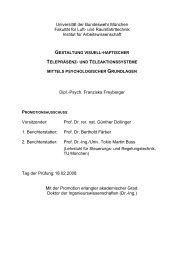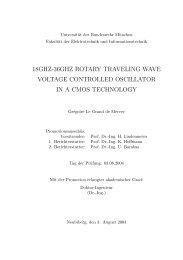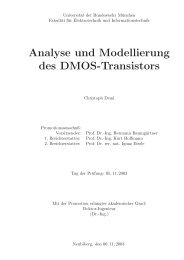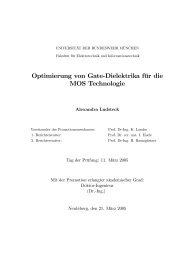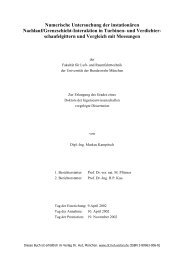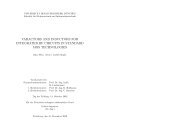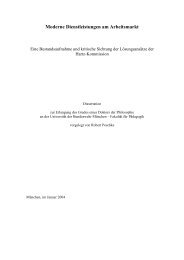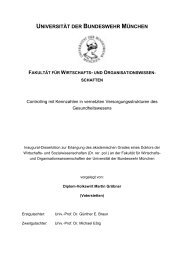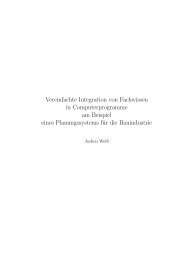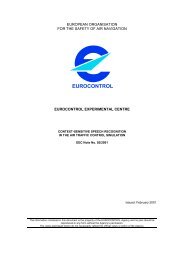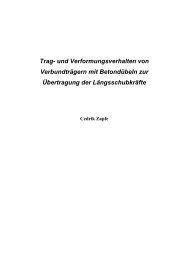Precise Orbit Determination of Global Navigation Satellite System of ...
Precise Orbit Determination of Global Navigation Satellite System of ...
Precise Orbit Determination of Global Navigation Satellite System of ...
Create successful ePaper yourself
Turn your PDF publications into a flip-book with our unique Google optimized e-Paper software.
Chapter 2 Observations <strong>of</strong> <strong>Orbit</strong> <strong>Determination</strong><br />
S ( t2<br />
) the geocenter vector <strong>of</strong> ground tracking station at t 2<br />
From Figure 2-1,<br />
1<br />
1<br />
2<br />
1<br />
2<br />
T<br />
1<br />
2<br />
1<br />
2<br />
S = || r ( t ) − S ( t ) || = {[ r ( t ) − S ( t )] [ r ( t ) − S ( t )]}<br />
(2-2)<br />
2<br />
1<br />
S<br />
= [ r(<br />
t ) − S ( t )] [ r(<br />
t ) − S ( t )] = [ r ( t ) r(<br />
t ) − r ( t ) S ( t ) − S ( t ) r(<br />
t ) + S ( t ) S ( t )<br />
= r<br />
T<br />
1<br />
( t ) r ( t ) + S<br />
1<br />
1<br />
2<br />
T<br />
T<br />
( t ) S ( t ) − 2r<br />
( t ) S ( t )<br />
2<br />
1<br />
2<br />
2<br />
T<br />
1<br />
T<br />
1<br />
2<br />
1<br />
T<br />
1<br />
Eq.(2-1) can be written as<br />
L = c t − t ) = || r(<br />
t ) − S ( t ) ||<br />
(2-4)<br />
( 2 1 1 2<br />
By linearizing Eq. (2-4), Eq.(2-1) becomes<br />
0<br />
0 0 ∂L<br />
∂L<br />
L = L + δ L = || r ( t1)<br />
− S ( t2)<br />
|| + δr<br />
( t1)<br />
+ δS<br />
( t2)<br />
(2-5)<br />
∂r<br />
( t1)<br />
∂S<br />
( t2)<br />
where the partial derivatives are<br />
T<br />
T<br />
∂L<br />
[ r(<br />
t1)<br />
− S ( t2<br />
)] [ r ( t1)<br />
− S ( t 2 )]<br />
=<br />
=<br />
(2-6)<br />
∂r<br />
( t1)<br />
|| r(<br />
t1)<br />
− S ( t2<br />
) || L<br />
T<br />
T<br />
∂L<br />
[ r ( t1)<br />
− S ( t2)]<br />
[ r ( t1)<br />
− S ( t2)]<br />
= −<br />
= −<br />
(2-7)<br />
∂S<br />
( t ) || r ( t ) − S ( t ) || L<br />
2<br />
1<br />
2<br />
∂r(<br />
t1)<br />
∂r<br />
( t1)<br />
∂p(<br />
t1)<br />
δ r( t1)<br />
= δr(<br />
t0)<br />
+<br />
δp(<br />
t0)<br />
(2-8)<br />
∂r(<br />
t0)<br />
∂p(<br />
t1)<br />
∂p(<br />
t0)<br />
where<br />
p dynamical model parameters <strong>of</strong> satellite orbit<br />
Inserting Eq.(2-6) - Eq.(2-8) into Eq.(2-5), the final linear observation equation can be written as<br />
T<br />
T<br />
[ r(<br />
t1)<br />
− S ( t 2 )] ∂r(<br />
t1)<br />
∂r<br />
( t1)<br />
∂p(<br />
t1)<br />
[ r ( t1)<br />
− S ( t 2 )]<br />
δL<br />
= [ δr(<br />
t0<br />
) +<br />
δp(<br />
t0<br />
)] −<br />
δS<br />
( t 2 )<br />
(2-9)<br />
0 r(<br />
t ) p(<br />
t ) p(<br />
t )<br />
0<br />
L ∂<br />
∂ ∂<br />
L<br />
where<br />
t 0<br />
initial epoch<br />
0<br />
1<br />
0<br />
2.1.1.2 Error Budgets<br />
The accuracy <strong>of</strong> range observations is dependent on the chip rate or frequency. Discussion in detail about<br />
influence on range measurements from various error sources such as tropospheric, ionospheric errors and<br />
multipath effect are given in Chapter 4. In this section the major error sources <strong>of</strong> range measurement related to<br />
the receiver are discussed and the error budget based on experiences <strong>of</strong> current satellite navigation systems is<br />
presented.<br />
Range measurements are implemented inside the receiver in two ways: 1) tone range; 2) pseudocode ranging like<br />
GPS C/A code measurements. The major error sources related to receivers are the following two types.<br />
i) Tone Range Error<br />
The accuracy <strong>of</strong> ranging is set by the highest major carrier frequency and the signal-to-noise ratio:<br />
c 1<br />
σ r =<br />
2 2πf<br />
s<br />
where<br />
K<br />
S / N<br />
(2-10)<br />
σ r distance error<br />
c speed <strong>of</strong> light<br />
fs major tone frequency<br />
S/N signal-to-noise ratio<br />
K receiver-related parameter<br />
ii) Pseudonoise(PN)-Code Ranging Error with Delay Lock Loop (DLL)<br />
For a Delay Lock Loop, the accuracy <strong>of</strong> range measurement can be expressed by<br />
4<br />
2<br />
T<br />
2<br />
1<br />
T<br />
2<br />
2<br />
(2-3)



